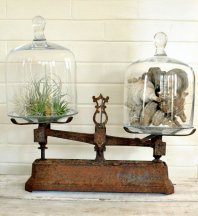antique cast iron weighing scales

Even though the basic balance scale has been around for thousands of years and its accuracy has improved dramatically over the last several centuries, the principle behind this tool remains unchanged. Its parts include a fulcrum, a beam that balances on it, two pans at the ends of the beam to hold the materials to be weighed, and counter-balancing weights.
Balance scales that require equal weights on each side of the fulcrum have been used by everyone from apothecaries and assayers to jewelers and postal workers. The most accurate mechanical equal-arm scales, as they are called, are housed in wood-and-glass cases to keep dust from tipping the scales, so to speak. Firms known for their high-quality balance scales include Philip Harris of England, Becker of Belgium, and U.S. maker Kohlbusch.
In the 19th century, portable suspension balance scales were used to weigh coins—in those days, it was not uncommon for the value of the gold in a coin to exceed the coin’s stamped denomination. These scales, which could be hung from the nearest hook, were designed to fit into metal or wooden cases, including their brass pans and cast-iron or lead weights.
Another type of balance scale has a weighing pan on one side and an arm on the other. Known as an unequal arm balance scale, this variety builds the counterweight into the device. Ball scales are good examples of these sorts of scales, as are union scales.
Counter scales used in dry-goods stores featured Japanned (blackened) cast iron and bronze trim. Made by companies such as Howe and Fairbanks, the footed tin pans of these scales were often oblong, some encircled at one end so bulk items could be easily poured into a bag. Seamless pans were typically stamped from brass and given style names like Snuff (the smallest) and Birmingham (the largest). Some counter scales were designed for measuring spices, others for weighing fat slices of cake.
Yet another type of unequal arm balance scale was the steelyard scale, which was designed to be mounted to a wall. The most ingenious steelyard scales could be folded against the wall they were attached to so they could be moved out of the way when not in use.
In the 18th century, spring scales appeared. To produce these scales, a manufacturer would use the resistance of a spring to calculate weights, which could be read automatically ...
One of the most common types of spring scales was the kitchen scale—also known as a family or dial scale. Designed for horizontal surfaces, these scales used the weight of goods in a pan at the top of the scale to force the spring down. Such scales were common in early-20th-century households and were sold by Sears and Montgomery Ward. Many had flat weighing surfaces but some were topped by shallow pans. Companies such as Salters, Chatillon, and Fairbanks made both.
One specialized type of spring scale was the egg scale, which was used to compute the weight of an egg, the weight of a dozen eggs, and whether the egg could be classified as small, medium, large, or extra large. Jiffy-Way scales, which were made in Owatonna, Minnesota, beginning in 1940, are popular with collectors for their attractive red painted-metal housings. Another Minnesota company, Specialty Mfg., Co., was known for its Acme egg scale.
Even more particular are the spring scales made by Salters that featured a wicker basket on top rather than a tinned pan. The reason? These handsome scales were designs exclusively to weigh newborn babies.
Finally, there are hanging spring scales made by numerous manufacturers, including the prolific Landers, Frary & Clark. Most of these scales had rectangular, vertically oriented brass faces, although some featured round dials—they were used for weighing farm goods like butter. Capacities ranged from 12 to 24 to 50 pounds.
Related posts:

 One of the more cost-effective measurements in a paper mill is that which monitors the flow of pulp stock into the head box of the paper machine. The stock level…
One of the more cost-effective measurements in a paper mill is that which monitors the flow of pulp stock into the head box of the paper machine. The stock level… Why is taking all the tricks called a boston in pinochle what are kegel exercises How to change administrator on windows 10? In what order should you learn tricks…
Why is taking all the tricks called a boston in pinochle what are kegel exercises How to change administrator on windows 10? In what order should you learn tricks… Overview Marel Marine Scales are specifically designed for use on board fishing vessels and factory trawlers. This cost-effective series of scales ranges from the…
Overview Marel Marine Scales are specifically designed for use on board fishing vessels and factory trawlers. This cost-effective series of scales ranges from the… How long to air fry french fries what does fafsa stand for What does it mean when ypu use alocohol and the tips of your fingers turn white Who raps bitches aint…
How long to air fry french fries what does fafsa stand for What does it mean when ypu use alocohol and the tips of your fingers turn white Who raps bitches aint… Globe s portion control scales can be used in a wide spectrum of applications from delis and pizza parlors, to bakeries and restaurants, or any establishment where…
Globe s portion control scales can be used in a wide spectrum of applications from delis and pizza parlors, to bakeries and restaurants, or any establishment where…